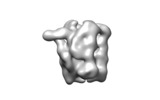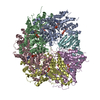+ Open data
Open data
- Basic information
Basic information
| Entry | Database: EMDB / ID: EMD-20159 | ||||||||||||
|---|---|---|---|---|---|---|---|---|---|---|---|---|---|
| Title | Rotavirus A-VP3-8mer ssRNA complex (RVA-VP3-RNA) | ||||||||||||
 Map data Map data | Rotavirus-A VP3 tetramer binding with 8-mer ssRNA | ||||||||||||
 Sample Sample |
| ||||||||||||
| Biological species |  Rotavirus A Rotavirus A | ||||||||||||
| Method | single particle reconstruction / cryo EM / Resolution: 11.8 Å | ||||||||||||
 Authors Authors | Kumar D / Yu X | ||||||||||||
| Funding support |  United States, 3 items United States, 3 items
| ||||||||||||
 Citation Citation |  Journal: Sci Adv / Year: 2020 Journal: Sci Adv / Year: 2020Title: 2.7 Å cryo-EM structure of rotavirus core protein VP3, a unique capping machine with a helicase activity. Authors: Dilip Kumar / Xinzhe Yu / Sue E Crawford / Rodolfo Moreno / Joanita Jakana / Banumathi Sankaran / Ramakrishnan Anish / Soni Kaundal / Liya Hu / Mary K Estes / Zhao Wang / B V Venkataram Prasad /  Abstract: In many viruses, including rotavirus (RV), the major pathogen of infantile gastroenteritis, capping of viral messenger RNAs is a pivotal step for efficient translation of the viral genome. In RV, VP3 ...In many viruses, including rotavirus (RV), the major pathogen of infantile gastroenteritis, capping of viral messenger RNAs is a pivotal step for efficient translation of the viral genome. In RV, VP3 caps the nascent transcripts synthesized from the genomic dsRNA segments by the RV polymerase VP1 within the particle core. Here, from cryo-electron microscopy, x-ray crystallography, and biochemical analyses, we show that VP3 forms a stable tetrameric assembly with each subunit having a modular domain organization, which uniquely integrates five distinct enzymatic steps required for capping the transcripts. In addition to the previously known guanylyl- and methyltransferase activities, we show that VP3 exhibits hitherto unsuspected RNA triphosphatase activity necessary for initiating transcript capping and RNA helicase activity likely required for separating the RNA duplex formed transiently during endogenous transcription. From our studies, we propose a new mechanism for how VP3 inside the virion core caps the nascent transcripts exiting from the polymerase. | ||||||||||||
| History |
|
- Structure visualization
Structure visualization
| Movie |
 Movie viewer Movie viewer |
|---|---|
| Structure viewer | EM map:  SurfView SurfView Molmil Molmil Jmol/JSmol Jmol/JSmol |
| Supplemental images |
- Downloads & links
Downloads & links
-EMDB archive
| Map data |  emd_20159.map.gz emd_20159.map.gz | 9.8 MB |  EMDB map data format EMDB map data format | |
|---|---|---|---|---|
| Header (meta data) |  emd-20159-v30.xml emd-20159-v30.xml emd-20159.xml emd-20159.xml | 11.1 KB 11.1 KB | Display Display |  EMDB header EMDB header |
| Images |  emd_20159.png emd_20159.png | 40.4 KB | ||
| Archive directory |  http://ftp.pdbj.org/pub/emdb/structures/EMD-20159 http://ftp.pdbj.org/pub/emdb/structures/EMD-20159 ftp://ftp.pdbj.org/pub/emdb/structures/EMD-20159 ftp://ftp.pdbj.org/pub/emdb/structures/EMD-20159 | HTTPS FTP |
-Validation report
| Summary document |  emd_20159_validation.pdf.gz emd_20159_validation.pdf.gz | 78.4 KB | Display |  EMDB validaton report EMDB validaton report |
|---|---|---|---|---|
| Full document |  emd_20159_full_validation.pdf.gz emd_20159_full_validation.pdf.gz | 77.5 KB | Display | |
| Data in XML |  emd_20159_validation.xml.gz emd_20159_validation.xml.gz | 494 B | Display | |
| Arichive directory |  https://ftp.pdbj.org/pub/emdb/validation_reports/EMD-20159 https://ftp.pdbj.org/pub/emdb/validation_reports/EMD-20159 ftp://ftp.pdbj.org/pub/emdb/validation_reports/EMD-20159 ftp://ftp.pdbj.org/pub/emdb/validation_reports/EMD-20159 | HTTPS FTP |
-Related structure data
- Links
Links
| EMDB pages |  EMDB (EBI/PDBe) / EMDB (EBI/PDBe) /  EMDataResource EMDataResource |
|---|
- Map
Map
| File |  Download / File: emd_20159.map.gz / Format: CCP4 / Size: 12.9 MB / Type: IMAGE STORED AS FLOATING POINT NUMBER (4 BYTES) Download / File: emd_20159.map.gz / Format: CCP4 / Size: 12.9 MB / Type: IMAGE STORED AS FLOATING POINT NUMBER (4 BYTES) | ||||||||||||||||||||||||||||||||||||||||||||||||||||||||||||||||||||
|---|---|---|---|---|---|---|---|---|---|---|---|---|---|---|---|---|---|---|---|---|---|---|---|---|---|---|---|---|---|---|---|---|---|---|---|---|---|---|---|---|---|---|---|---|---|---|---|---|---|---|---|---|---|---|---|---|---|---|---|---|---|---|---|---|---|---|---|---|---|
| Annotation | Rotavirus-A VP3 tetramer binding with 8-mer ssRNA | ||||||||||||||||||||||||||||||||||||||||||||||||||||||||||||||||||||
| Projections & slices | Image control
Images are generated by Spider. | ||||||||||||||||||||||||||||||||||||||||||||||||||||||||||||||||||||
| Voxel size | X=Y=Z: 1.74 Å | ||||||||||||||||||||||||||||||||||||||||||||||||||||||||||||||||||||
| Density |
| ||||||||||||||||||||||||||||||||||||||||||||||||||||||||||||||||||||
| Symmetry | Space group: 1 | ||||||||||||||||||||||||||||||||||||||||||||||||||||||||||||||||||||
| Details | EMDB XML:
CCP4 map header:
| ||||||||||||||||||||||||||||||||||||||||||||||||||||||||||||||||||||
-Supplemental data
- Sample components
Sample components
-Entire : VP3-8-mer ssRNA complex
| Entire | Name: VP3-8-mer ssRNA complex |
|---|---|
| Components |
|
-Supramolecule #1: VP3-8-mer ssRNA complex
| Supramolecule | Name: VP3-8-mer ssRNA complex / type: complex / ID: 1 / Parent: 0 / Macromolecule list: #1 / Details: VP3 tetramer binding with 8-mer ssRNA |
|---|---|
| Source (natural) | Organism:  Rotavirus A Rotavirus A |
| Recombinant expression | Organism:  |
-Experimental details
-Structure determination
| Method | cryo EM |
|---|---|
 Processing Processing | single particle reconstruction |
| Aggregation state | particle |
- Sample preparation
Sample preparation
| Concentration | 0.3 mg/mL |
|---|---|
| Buffer | pH: 7 |
| Grid | Support film - Material: GRAPHENE OXIDE / Support film - topology: CONTINUOUS / Details: unspecified |
| Vitrification | Cryogen name: ETHANE / Chamber humidity: 95 % / Chamber temperature: 295 K / Instrument: FEI VITROBOT MARK IV |
- Electron microscopy
Electron microscopy
| Microscope | JEOL 3200FSC |
|---|---|
| Image recording | Film or detector model: GATAN K2 SUMMIT (4k x 4k) / Detector mode: SUPER-RESOLUTION / Digitization - Dimensions - Width: 7420 pixel / Digitization - Dimensions - Height: 7676 pixel / Number grids imaged: 1 / Average exposure time: 10.0 sec. / Average electron dose: 50.0 e/Å2 |
| Electron beam | Acceleration voltage: 300 kV / Electron source:  FIELD EMISSION GUN FIELD EMISSION GUN |
| Electron optics | C2 aperture diameter: 100.0 µm / Illumination mode: FLOOD BEAM / Imaging mode: BRIGHT FIELD / Cs: 4.7 mm / Nominal defocus max: 2.0 µm / Nominal defocus min: 1.0 µm / Nominal magnification: 40000 |
 Movie
Movie Controller
Controller














 Z (Sec.)
Z (Sec.) Y (Row.)
Y (Row.) X (Col.)
X (Col.)





















